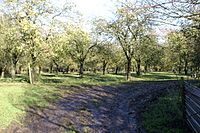- This page was last modified on 17 October 2025, at 10:18. Suggest an edit.
Kenn Church, Kenn Pier & Yew Tree Farm SSSI facts for kids
| Site of Special Scientific Interest | |
 |
|
| Area of Search | Avon |
|---|---|
| Coordinates | 51°25′17″N 2°50′34″W / 51.4215°N 2.8427°W |
| Interest | Geological |
| Area | 15.37 hectares (0.1537 km2; 0.0593 sq mi) |
| Notification | 1997 |
Kenn Church, Kenn Pier & Yew Tree Farm is a very special place in Somerset, England. It is known as a Site of Special Scientific Interest (SSSI). This means it is protected because it has important natural features. This SSSI was officially recognized in 1997. It covers about 15.37 hectares, which is like 38 football fields! This site is important for understanding the Earth's history.
Contents
Why is This Place Special?
This SSSI is listed in the Geological Conservation Review. This review helps protect the most important geological sites in Great Britain. Kenn Church, Kenn Pier & Yew Tree Farm is special because of its amazing layers of soil and rock. These layers tell a story about how the Earth has changed over thousands of years.
Layers of Time: Understanding Sediments
The site has a complex sequence of Pleistocene sediments. Sediments are tiny bits of rock, sand, and mud that settle over time. The Pleistocene Epoch was a period in Earth's history that lasted from about 2.6 million to 11,700 years ago. This time included many ice ages.
What are Pleistocene Sediments?
At the very bottom of the layers, you can find coarse glacial outwash gravels. These are rough stones and pebbles left behind by melting glaciers. Imagine a giant ice cube melting and leaving a mess of rocks!
Above these gravels are different kinds of sands. These sands were laid down during warmer periods between the ice ages. They show how the area changed from freshwater lakes to salty estuaries (where rivers meet the sea) and even to marine (ocean) environments.
The Top Layers: Wind and Water
On top of all these sands, there are more layers. The next layer is made of aeolian coversands. "Aeolian" means they were carried and deposited by the wind. Think of sand dunes forming in a desert, but here it was during a different climate.
Finally, the very top layers are Holocene silts. The Holocene Epoch is the time period we live in now, starting about 11,700 years ago. Silts are very fine particles of soil, often carried by water. These top layers show how the landscape has continued to change even after the last ice age.
